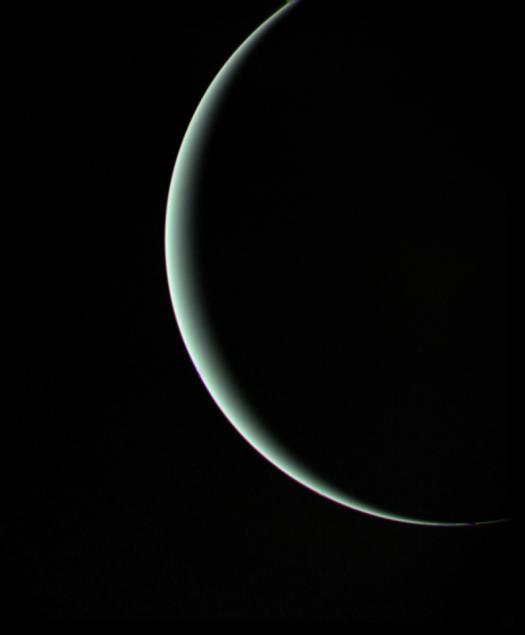







| BOOKS | F. A. Q. | ARTICLES | TALKS | ABOUT KEN | DONATE | BEYOND OUR KEN |
|---|
By Ken Croswell
Published on New Scientist (October 14, 2016)

Credit: Voyager 2. NASA/JPL
Uranus may have two small moons that no one has ever seen, orbiting closer to the planet than any of its other satellites and making wavy patterns in the planet’s rings.
The ice giant has 27 known moons, far fewer than the 67 and 62 of its neighbours Jupiter and Saturn, respectively. Uranus is a smaller planet, which may explain the difference.
But it might just be that we haven’t previously had a chance to look for more moons. Unlike its larger brethren, Uranus has entertained only one passing spacecraft – Voyager 2, which tripled the number of known Uranian moons in its 1986 flyby. Uranus is also yet to receive an orbiting spacecraft like Jupiter’s Galileo and Juno, or Saturn’s Cassini.
In addition to its moons, Uranus has dark, narrow rings. Scientists detected the first of these in 1977, when the planet and its rings blocked the light from a distant star. Voyager 2 later discovered two moons, Cordelia and Ophelia, on either side of the outermost ring, named Epsilon. The gravitational pulls of the two moons herd the ring’s particles into a narrow formation.
Small, dark satellites
Now planetary scientists Rob Chancia and Matthew Hedman at the University of Idaho in Moscow have re-examined Voyager data and discovered wavy patterns in two other rings, Alpha and Beta. These may similarly arise from the gravitational tug of a moon that lies outside each ring.
“These moons are pretty tiny,” says Chancia, at only 4 to 14 kilometres across if they exist. That means they’re probably smaller than any Uranian satellite known – and too diminutive for Voyager to have seen clearly. Still, at least four of Saturn’s moons are even smaller.
The two putative moons are probably dark, based on the colours of their neighbours. “Not only are Uranus’s rings dark, so are most of the little satellites that are in that region,” says Hedman.
The existence of the two moons is “certainly a very plausible possibility”, says Mark Showalter of the SETI Institute in Mountain View, California, who has discovered moons around Saturn, Uranus, Neptune, and Pluto.
In the coming months, Showalter and his colleagues will examine observations of Uranus by the Hubble Space Telescope, which spotted Pluto’s four smallest moons years before the New Horizons spacecraft visited in 2015. He calls Hubble “the best bet” for finding the Uranian satellites, adding that characterising their orbits is very useful.
If a Hubble search fails, a Uranus orbiter could someday succeed – or else rule out the moons’ existence altogether. “That would definitely be a good way to do it,” says Hedman.
Ken Croswell earned his Ph.D. in astronomy from Harvard University and is the author of The Alchemy of the Heavens and The Lives of Stars.
"An engaging account of the continuing discovery of our Galaxy...wonderful." --Owen Gingerich, The New York Times Book Review. See all reviews of The Alchemy of the Heavens here.
"A stellar picture of what we know or guess about those distant lights."--Kirkus. See all reviews of The Lives of Stars here.
| BOOKS | F. A. Q. | ARTICLES | TALKS | ABOUT KEN | DONATE | BEYOND OUR KEN |
|---|